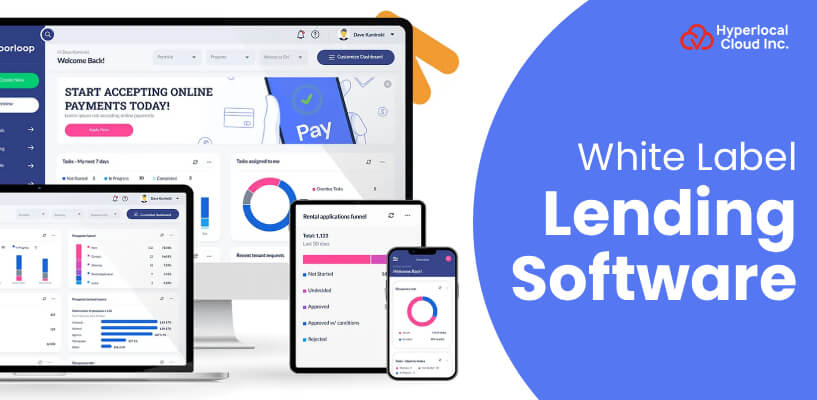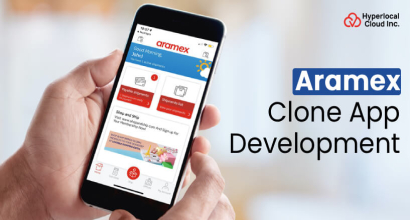Demand for digital economic solutions is increasing rapidly in the world of finance and technology. With progress in AI, machine learning, and blockchain technology, an increasing number of businesses are in search of efficient and customizable lending platforms to meet customer needs. One of the most popular solutions that has emerged in recent years is white label lending software.
The software solution enables companies to offer their own loan services at an affordable rate. This means businesses and startups have a golden opportunity to start their business journey and boost their earnings with an online lending application. In this blog, we will provide a thorough examination of lending software, its most important functions, benefits, market trends, and how businesses can utilize it to their advantage.
Overview of A Lending Software
Lending platforms are designed to reshape the finance market by automating the loan process. This approach will allow the lenders to track, plan, process, and manage the overall loan process. The software can handle a variety of tasks, including origination, credit risk assessment, loan service, payment processing, and collections.
There are comprehensive types of lending software. Let's have a look:
1. Loan Origination Systems
These systems handle the entire process from submitting loan applications to approval. These usually include credit checks, document verification, and risk assessment.
2. Loan Management Systems
Once the loan is approved, loan management platforms make sure to track the loan process and its progress, including payments, returns, or closures.
3. P2P Lending Platforms
The peer-to-peer lending platforms enable the borrower to directly connect with the investors and lenders. This, however, will reduce the chances of interference from any third party.
Build a Lending Platform That Works for You!
How Does the Lending App Work?
A lending software is operated by several steps, which make its operation smooth and user-friendly. All the necessary steps are discussed below.
1. User Registration
Borrowers must register on the platform, where they are required to submit information such as personal details and financial details.
2. Loan Application
The borrower chooses loan amounts, terms, and purposes. The app then collects all necessary documents for evaluation.
3. Credit Assessment
Using algorithms and AI, the app evaluates the borrower's creditworthiness by assessing important factors, including credit score, income, debt, and financial history.
4. Approval/Rejection
Based on the credit rating, the app approves or rejects the loan application. Upon approval, loan terms, interest, and repayment will be granted.
5. Disbursement
When the borrower accepts the terms, the loan amount is paid through a bank transfer or digital wallet.
6. Repayment
The borrower pays the loan in installments, with payments automatically deducted from their account on a scheduled basis.
7. Collections
If a payment is missed, the app triggers automatic reminders or collection processes. This is a secure yet effective method.
Advantages of Investing in White Label Lending Software
Utilizing a white label solution for the development of a lending software is a wise investment for businesses or startups that are going to start their business journey at an initial level. Here are several benefits of the same.
1. Pocket-friendly Solution
Building a lending platform from scratch can be expensive and time-consuming. White label solutions give companies a fully functional platform at a fraction of the cost of growing.
2. Quick Time-to-Market
Since the software is pre-built, you can start the lending platform much faster than developing it from scratch. Bringing a white label solution to the market usually takes a few months, while building a customized solution can take a year or more.
3. Customization
The white label solutions are ready-made and are already developed with a wide range of core features that make the platform robust. But businesses get the liberty to customize the software, which shows their brand value and sets a unique approach in the market.
4. Security
White label lending software is secure because it is 100% encrypted and follows a lot of security protocols that increase its reliability among users.
5. Compliance with Regulations
Compliance with financial regulations is important for any loan business. White label loan software is designed to be fully in accordance with local and international lending regulations, making it easy to navigate complex legal requirements.
List of the Core Features of a Lending App
The lending application is made with a wide range of advanced features that are useful for the borrower panel, the lender panel, and the admin panel. Just look at the information below, and review the features of each panel.
Borrower Panel
1. User Registration & Profile Creation
Users can register, create a profile, and provide the necessary documents. This step is required for verification purposes.
2. Loan Application
Users can apply for a loan, select the amount, the time, and the repayment plan. This is a user-friendly and faster process.
3. Credit Score Monitoring
Borrowers can check their credit points and get feedback on the qualifying score. This will help users to be up-to-date about the loan progress.
4. Loan Management
Users can track the status of their loan, which lets them know the loan status. Thus, the feature attracts more users and is helpful for businesses to build a strong user base.
5. Repayment Tracker
With the repayment tracker, users will get timely alerts that let them know about future payments. With the help of this, users can manage their expenses accordingly.
6. Customer Support
This feature typically helps borrowers get customer support in case of any inconvenience or loan-related queries.
Lender Panel
1. Loan Listings
The feature enables lenders to help them see loan applications that match the criteria and choose to finance them.
2. Risk Assessment Tools
Lenders can use the risk assessment tools in order to evaluate the borrower risk profiles and make informed decisions.
3. Loan Portfolio Management
With the help of loan portfolio management, lenders can easily track all their investments, refunds, and returns in one place.
4. Automated Payment Collection
The system ensures automated collection and reporting of refunds. Thus, this will make the app user-friendly and secure.
5. Analytics and Reporting
The service provides lenders with detailed reports of performance, defaults of loans, and other important calculations.
Admin Panel
1. Dashboard
A centralized control panel to monitor all platform activities. This will allow admins to check out the borrower and lender's profiles throughout the loan processing.
2. User Management
Administrators can manage the borrowers and lenders, approve applications, and solve any problems that arise.
3. Loan Tracking
This feature will help the admins to track loan applications, approvals, payments, refunds, and defaults in order to reduce the chances of scams.
4. Reporting and Analytics
The report provides insight into the platform, customer behavior, and loan performance. With this, admins can get an insight into the overall revenue generated from the platform.
5. Compliance Management
The feature of compliance management ensures that all operations are in accordance with local regulations and laws.
Launch Your Own Lending Platform Today
How Artificial Intelligence Transforms Lending Platforms?
AI transforms the lending platforms in many ways, of which the main ones are precisely discussed below. All you need to do is check out the information.
1. Automated Credit Scoring
AI-driven credit scoring models consider a person's borrowing creditworthiness by inspecting a more extensive set of data points beyond the classic credit score.
2. Fraud Detection
AI-driven fraud detection can investigate inappropriate data automatically in a timely manner, which makes the platform more efficient than manual systems.
3. Loan Origination Process
AI automates the getting operation by verifying documents, upholding creditworthiness, and steadily generating loan terms. This reduces human errors and speeds up the application method.
4. Predictive Analytics
AI can predict loans by evaluating historical data and the borrower's performance. This allows lenders to set believable interest rates and reduce the risk.
Explore the Process to Build a Lending Platform
In the process of building a lending platform, several steps are included that are equally responsible for making the application advanced and feature-enriched. Just have a look below and get an idea of how to create a money lending app.
1. Define the Business Model and Objectives
Get an in-depth knowledge of the lending or loan management market so that you can start your business journey with all the market research and current ongoing trends. You should analyze your competitors in order to improve your strategies and resolve the pain points that users typically face.
2. Select the Right Technology Stack
The following tech stack that businesses can consider:
Frontend Development
React, Vue.js, or Angular
Backend Development
Node.js, Django, or Ruby on Rails
Database
MySQL, PostgreSQL, and MongoDB
Payment Gateway Integration
Stripe, PayPal, or Razorpay
Cloud Hosting
AWS, Google Cloud, or Azure
3. Platform Design
Whether you develop for desktop or mobile, the platform should be intuitive, easy to use, and responsive. Too much complexity in the design will create unnecessary intricacies that, however, decrease user experience. That's why it is suggested that the UI/UX should be simple enough to naturally attract the users.
4. Development
Once you have done with the design part, it is now time to begin with the development process, which can be done either from scratch or by utilizing a white label solution. Businesses get the choice to select one of the development approaches, which makes the application more reliable and advanced.
5. Testing and Quality Assurance
The testing and quality assurance give the surety that the platform is secure and ready to be launched without any bugs, errors, or glitches. The very common types of testing typically include:
- Functional Testing
- Security Testing
- Usability Testing
6. Launch
The launching process should be as smooth as the application, which means businesses are enabled to launch the application on different operating systems, attracting a wide range of audiences.
The Challenges and Complexities in Lending Software
Numerous challenges and complexities exist that businesses should know while developing a lending application. Have a look:
1. Regulatory Compliance
Financial services, particularly lending, are strongly adjusted. Each country has its own set of limitations that affect the issuance, batch, and repayment of loans.
2. Security and Data Protection
Lending platforms' commitment to significantly sensitive personal and financial information, ensuring the data privacy and security of data is a supreme priority. The challenges include:
- Data Breaches
- Encryption
- Compliance with Data Protection Laws
3. User Trust and Adoption
Users should be assured that the money and personal information are in safe hands. For new lending platforms, getting user assurance can be a massive complication.
4. Managing Loan Defaults
One of the vital risks of lending is the prospect of defaulting on loans. Despite these strategies, defaults may occur, resulting in financial losses. This risk can be reduced by:
- Credit Scoring
- Debt Collection
5. Technological Integration
Integrating third-party services such as payment gateways, AI-driven fraud detection, or loan credit integration are the complexities to introduce in the platform.
Start Your Lending Business in Days, Not Months
For Whom is a Lending App?
The application is versatile; however, it is used by many. The list mentioned below will let you know who can use the lending app.
1. Individual Borrowers
Individual borrowers are probably the most common users of lending apps. These can be individuals looking for personal loans, educational loans, mortgages, or small loans for unexpected expenses.
2. Small and Medium Enterprises
SMEs frequently face challenges when in search of loans from traditional financial institutions because of a loss of established credit score history, insufficient collateral, or restricted monetary objects.
3. Lenders and Investors
Lenders and traders are some other crucial target audiences for lending apps, specifically Peer-to-peer (P2P) lending platforms. These folks or establishments lend cash to borrowers in exchange for interest, with the app performing as an intermediary.
4. Financial Institutions
Banks, credit associations, and other financial institutions can also benefit from lending apps by using white label loan software or integrating it into their existing infrastructure.
What is the Future Worth of a Lending Platform?
The future of a lending platform is as lucrative as the application is currently. However, below you will get a brief overview of the same. Just have a look:
1. Adoption of AI and Machine Learning
AI and MLA are expected to play an increasingly crucial role in automating loan evaluation, enhancing credit scoring, detecting fraud, and offering private loan options.
2. Blockchain and Decentralized Lending
Blockchain technology has the potential to revolutionize lending by making decentralized platforms where loans are issued and tracked on a public main ledger. This reduces the need for middlemen and increases openness.
3. Open Banking and API Integrations
The idea of Open Bank, where financial establishments share data with third-party companies via steady APIs, will allow lending systems to provide more customized loans.
4. Global Expansion and Cross-Border Lending
When lending platforms mature, many expect to expand to global markets. With the increase in international digital wallets and the increasing acceptance of mobile payments, loans across national borders are expected to become more widespread.
5. Sustainable and Green Lending
As environmental concerns grow, lending structures can provide green loans to assist sustainability tasks or environmentally friendly enterprise companies. There is a developing demand for financing solutions that aid renewable power projects, power-efficient houses, and carbon-neutral startups.
Monetization Strategies to Generate Income from Lending Software
There are so many reliable and effective revenue generation models that can be helpful for businesses that want to monetize the lending software. Below are the essential models mentioned.
1. Loan Origination Fees
The loan's origin fee is one of the most common ways lending platforms generate revenue. These fees are charged to borrowers at the time of loan application or approval; however, the amount may vary depending on the size and loan type.
2. Interest on Loans
In peer-to-peer lending models, the platform typically burdens the interests that borrowers have earned. For example, the platform may require a percentage of interest rates that borrowers pay to lenders. This income can be significant, especially for high-interest platforms.
3. Service Fees for Lenders
Lending apps can charge lenders a fee for using the platform. These service fees can be charged for various activities, including the processing of loan requests, advantageous loan transfers, or managing loan portfolios.
4. Subscription Models
Some lending systems use a subscription model, where users pay a monthly or cyclical price to get access to top-rate functions, which include progressive chance assessments, prioritized mortgage treatment, or specialized financial equipment.
5. Advertisement Revenue
Lending platforms can especially generate revenue by showing targeted ads to users in the app. For instance, financial products such as insurance, credit cards, or investment instruments may be promoted to users seeking loans.
6. Data Monetization
Since lending apps collect large amounts of financial and user behavior data, they can potentially make money on this data by selling insights to third-party companies.
Build a Scalable Lending Platform Tailored to Your Brand
Create a Lending Platform with Hyperlocal Cloud!
Start your business journey with Hyperlocal Cloud by developing your own lending platform, which costs you $6,000. We have expertise in developing mobile apps for various industries using the white label solution. Our team of expert developers makes sure to integrate all the latest technologies in the application, which include AI, MLA, NLP, AR/VR, and third-party integrations. We are a leading industry pioneer offering a white label mobile banking app at very affordable prices to cater to your business. So, for what are you actually waiting? Pick up your phone, contact us, and leverage our expertise to reshape the lending market.



